Moscow
I was rather surprised to find that the largest European city is neither London nor Paris, but rather Moscow. With a population of 10-12 million it is easily the largest city in Europe. And of the great European cities it must also be by far the least visited. I think pretty much every person reading this would recognize the names "Kremlin", "Red Square", and the outline of the St. Vassiliy cathedral, but very few have actually seen these things.
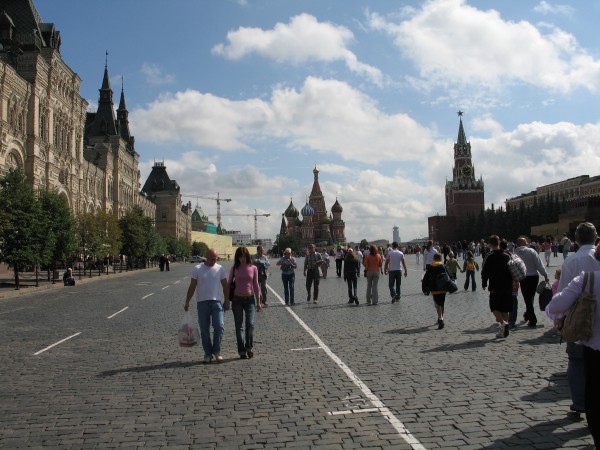
Red Square, Moscow |
The city
A lot of this has to do with Moscow's reputation, of course. My own vision of Moscow before I went there certainly included a huge, dark, polluted metropolis full of poor people and square, concrete stalinist buildings. And, of course, the nouveau riche, and criminals and gangsters all over. The reality was, of course, very different.
We arrived at Sheremetyevo airport, which is nothing much to look at, but neither is it hideously ugly. Finding the local bus route to the nearest metro station (as advised by Lonely Planet) took a little effort, and although the bus was rather old and scruffy, and the driver spoke no English, it worked out just fine. The biggest surprise on the drive was how wide the streets were, and how much green there was. As we got further in, in some places the trees were so thick we could hardly see the buildings along the street.
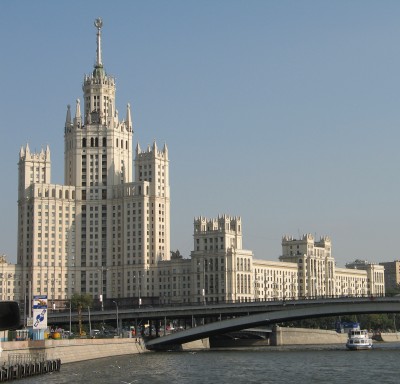
One of the Seven Sisters, Moscow |
Quite a few people on that bus were obviously poor, and a number were also obviously drunk, but most of them took care to dress well and looked much like people all over Europe. And while we must have looked like rich backpacking tourists to them, nobody paid us any attention. We were to find this experience repeated throughout the three weeks the holiday lasted. Once you get into the city centre, however, most signs of poverty are completely gone, and people seem to be as well off as in western Europe. There are normal shops, hotels, pubs, and restaurants. The city in general looks like a much larger version of some European capital, with a rather unusual architecture.
As for crime, we saw nothing to make us nervous throughout the entire holiday, not even late at night. The locals certainly did not seem worried about it, and young girls would wander alone everywhere at all times, and even play the guitar for money all alone in pedestrian underpasses at night.
Moscow definitely has a ritzy side as well, where the nouveau riche flaunt their money. There is no shortage of fancy restaurants, pubs, night clubs, and even grocery stores that are every bit as sophisticated as those in the west (and then some). Along Novy Arbat in central Moscow there is seemingly endless stretch of casinos clad in bright neon. Outside are parked Audis, BMWs, Mercedes's, and even the odd Lamborghini, and, of course, security guards with earpieces every 250 meters.
Architecture
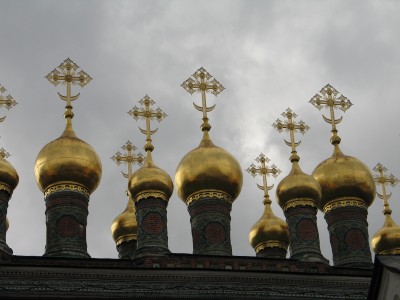
Forest of spires, Kremlin, Moscow |
The architecture was the real highlight of the city for me. Of course, much of it is stalinist, and quite a bit is absolutely hideous, but there are also a great number of surprises. Quite a few buildings in central Moscow are reasonably old, and I can't ever recall seeing so many different, new (to me) architectural styles as I did in Moscow. There are nondescript modern buildings, bizarre modern buildings, stalinist concrete boxes, imitations of French rococco, and a surprising number of tsarist and modern innovations. And innumerable churches and monasteries all over the city. From pretty much any metro exit you need only scan the horizon and you'll find at least one onion dome.
We saw a number of these churches: the famous St. Vassiliy, the churches inside the Kremlin, a couple more on the Red Square, Novodevichy Convent, and the Cathedral of Christ the Saviour (about which more later). These are only the ones whose names I remember; we also saw lots more dotted around the city.
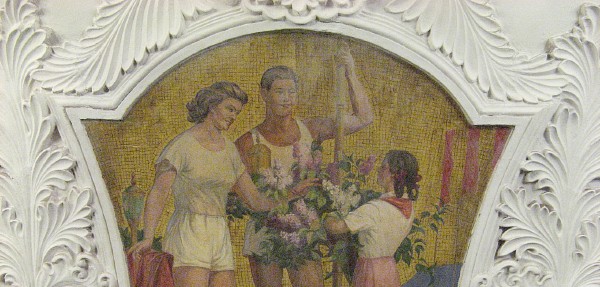
Mural, Moscow metro (partial) |
The Moscow metro has to count as one of the city's biggest attractions. The Lonely Planet guidebook describes it as fast, cheap, and reliable, and it certainly is all of those. It's spaciously built and well lit, so you never really feel like you are underground. Rather more surprisingly, it is also beautiful. It's also decorated with marble, copper, statues, frescos, and chandeliers. (Yes, I kid you not. Chandeliers in the metro!) The locals, who are not given to hyperbole, call it "the palaces of the people", and that seems entirely fair to me. If you ever visit Moscow I recommend spending some time in the metro to see as many different stations as you can. From what I hear there are about 170 of them, so this could take a while, but only the oldest (and newest) are really interesting. (My apologies for the metro photos; the best were lost, and not recovered.)
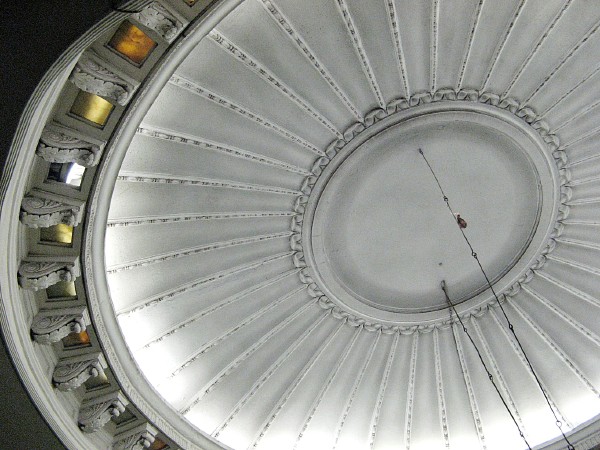
Ceiling, Moscow metro |
Cyrillic
However, to travel by metro in Moscow you really need to be able to read Cyrillic. That may sound like rather a tall order, but if you learn 4 letters a day you'll be done in a week. And you don't really need to be able to read quickly; reading at the speed of a 6-year old who still has to spell the words out loud is more than sufficient. You may have to stare at a sign for a full minute to figure out if it says "Kievskaya" or not, but so what?
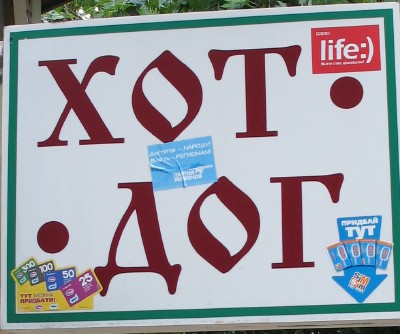
Hot dog sign, Yalta |
At this level of reading comprehension you read everything by spelling it out in your mind: "k-i-e-v-s-k-a-ya, ah, Kievskaya!" For some reason this makes any sign with English loan words on it very funny. Spotting "Дщекпот" and deciphering it as "d-zh-e-k-p-o-t", "ah!", "jackpot!" raises a laugh every time. The same goes for "kh-o-t d-o-g" (hot dog), and the French "m-a-s-s-a-zh" (massage).
It seems that many visitors to Moscow go through the same learning process. At one point we heard a voice behind us say "e-l-e-k-t-r-o-t-e-k-n-i-k-a". The voice turned out to belong to an Italian tourist who had just figured out what was on a sign nearby. We exchanged knowing smiles and moved on.
Going to Moscow
It seems most people who go to Moscow travel as part of a group, but I see no reason to do that, provided you are willing to spend a week learning Cyrillic. Arranging the trip can be something of a hassle, but not that much, and once you are there you really get to experience a city unlike all others.
A story may be the best way to explain what I mean. I mentioned the Cathedral of Christ the Saviour above, and there is a story attached to this cathedral. It was built over several decades during the 19th century, and was vast (some say the biggest cathedral in the world). The frescos alone took twenty years to paint, and the whole structure was decorated with precious stones and marble.
Stalin, however, decided to demolish it in order to build the Palace of the Soviets. This is, to put it mildly, astonishing. It's rather like Tony Blair tearing down St. Paul's (impossible), Jacque Chirac destroying Notre Dame (unthinkable), or Silvio Berlusconi demolishing St. Peter's. However, Stalin was Stalin, and nobody dared to stop him, so down the cathedral came in 1931. However, once the foundation hole had been dug, the project came to a halt because of problems with the ground and with the funding.
Khrushchev eventually turned the hole into the world's biggest swimming pool in the 1950s after Stalin's death. The water was kept a very warm 27C, even in winter, with the result that an eternal fog hung over the entire neighbourhood all winter, every winter. It seemed a ridiculously sad ending for a great cathedral, but once Soviet rule ended the Russian Orthodox Church asked for, and received, permission to rebuild it. Mayor Yuriy Luzhkov then had it rebuilt at a cost of EUR 280 million, and today the cathedral can once again be seen on the banks of the Moscow river.
Somehow this seems symbolic of both the city of Moscow and recent Russian history.
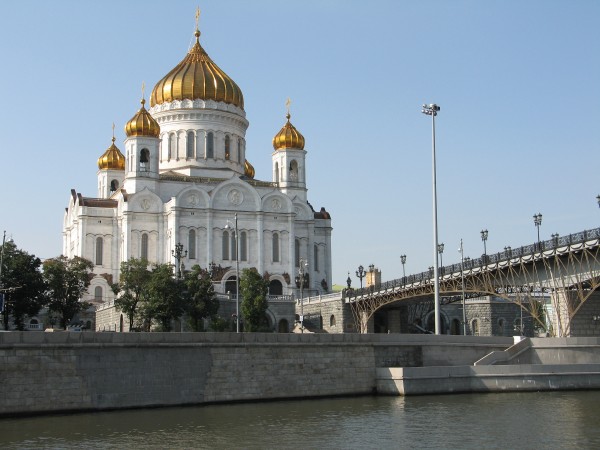
Cathedral of Christ the Saviour, Moscow |
Similar posts
VDNKh
I've hinted a couple of times in previous blog entries about "surprises" in Moscow, and the biggest of these was without question VDNKh, which has to rank near the top of the list of the most bizarre things I've ever seen
Read | 2008-02-03 13:42
Building a Nation
I left my hotel, crossed the river, and headed for the outskirts of town
Read | 2022-02-26 20:20
Comments
shibanibrits - 2012-04-22 04:24:12
Typical British supercilious description of one of the greatest cities in the world .Go back to London and admire the" old "and "extraordinary" beautiful eye of London
Lars Marius - 2012-04-22 05:51:49
shibanibrits: I'm Norwegian. Anyway, I agree, Moscow is definitely one of the great cities of the world.
shibanibrits - 2012-04-22 07:02:52
Is it? Stick to your computers. Don't try to describe something you don't realy understand.It is a different culture with a history path a way different from your counrty's one.Sorry for the mix-up.I tought you were English because of the typical British ignorance and contempt for the Russian culture.
Lars Marius - 2012-04-22 07:33:56
shibanibrits: I don't feel I have any contempt for Russian culture. Far from it, in fact. But I guess saying so doesn't help much.